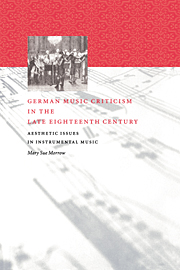Book contents
- Frontmatter
- Contents
- Acknowledgments
- Author's note
- Introduction: terms of discourse
- 1 What does instrumental music mean?
- 2 Answering with a unified voice
- 3 Answering with a German voice
- 4 Answering with aesthetic criteria
- 5 The importance of being correct
- 6 The reign of genius
- 7 A call to order
- 8 Epilogue: segue to the nineteenth century
- Notes
- Bibliography
- Index
5 - The importance of being correct
Published online by Cambridge University Press: 03 October 2009
- Frontmatter
- Contents
- Acknowledgments
- Author's note
- Introduction: terms of discourse
- 1 What does instrumental music mean?
- 2 Answering with a unified voice
- 3 Answering with a German voice
- 4 Answering with aesthetic criteria
- 5 The importance of being correct
- 6 The reign of genius
- 7 A call to order
- 8 Epilogue: segue to the nineteenth century
- Notes
- Bibliography
- Index
Summary
Neue Zeitungen von gelehrten Sachen (1766): Christian Ernst Rosenbaum, Sechs Sonaten.
Given the pitiful appearance this composer makes, we didn't know whether to pity or look down on him. We would gladly do the former, if we thought there were any chance that he might improve. But it appears that all hope is in vain, because the chastisement we gave him about his song melodies did so little good that he is now daring to come forth with a half dozen sonatas that are even more miserable than his songs. How empty of ideas! What incorrect phrasing! Now a beat too many, now one too few! And the mistakes in Harmonie! Parallel fifths and octaves everywhere! And what about good modulation, what about the relationship of related keys to the main key? Even the ear of a Hottentot would be able to sense how unnatural most of this is. You stagger about from one key to the next, only to discover in astonishment that the piece, when the page is full, cadences again in the tonic. How masterful! … The only good thing that we can find to say about these sonatas is that they are short and didn't waste more than six sheets of paper.
Wöchentliche Nachrichten (1769): Friedrich Schwindl, Six Simphonies.
[In the first symphony], the first movement was pleasant and passionate; the varied shadings and the modulations were effective. But then came a stiff, sluggish Andante, which did have some movement in the middle voices, but was so nonotonous begining to end that it went nowhere. […]
- Type
- Chapter
- Information
- German Music Criticism in the Late Eighteenth CenturyAesthetic Issues in Instrumental Music, pp. 79 - 98Publisher: Cambridge University PressPrint publication year: 1997

